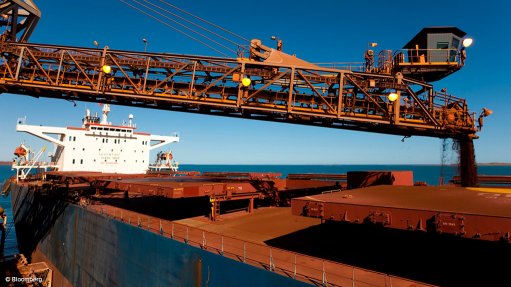
Photo by: Bloomberg
PERTH (miningweekly.com) – Higher iron-ore prices have helped to drive Australia’s resource export earnings to a record A$275-billion in the 2018/19 financial year, with export earnings expected to hit A$285-billion in 2019/20, data from the latest Resources and Energy Quarterly shows.
Chief economist Mark Cully on Monday noted that the fallout from the Brumadinho tailings dam collapse had led to a sharp drop in Brazilian iron-ore exports. This shortfall now looks set to last at least two years.
“The seaborne iron-ore market is thus likely to stay tight, and prices elevated, out to at least 2021. Extra Australian output will partly fill the gap, as mining expands and disruptive weather in Western Australia recedes. The weaker Australian dollar outlook has also pushed up our 2019/20 forecast,” Cully noted.
Australia exported 835-million tonnes of iron-ore in 2018, valued at A$64-billion, making Australia the largest iron-ore exporter in the world.
“Australia produces more than half of the world’s iron-ore and every year exports enough to build 10 000 Sydney Harbour bridges.
“Steel produced from Australian ore is building the new wave of global infrastructure, with around half being used for construction, and much of the rest for machinery and motor vehicles,” Minister for Resources and Northern Australia Matt Canavan said on Monday.
The export value of Australian iron-ore is expected to rise to A$79-billion in 2019/20, driven by the elevated prices and export volumes. Australia’s iron-ore exports are estimated to rise to some 869-million tonnes by 2020/21, driven by large-scale producers ramping up to long-term production targets.
Cully noted that partially offsetting the positive outlook for iron-ore was the tough climate faced by thermal coal, which was Australia’s fourth-largest export commodity.
“As a large producer and importer of thermal coal, China’s import policies, including extended customs clearance times, have added uncertainty into the market.
“Seasonal factors appear to have had a larger than normal impact this year: the northern hemisphere – where most thermal coal is burnt – has emerged from a warmer-than-usual winter, which reduced heating-related energy use. Peak summer demand, when air conditioner use rises, is a month away,” Cully said.
Australia exported 208-million tonnes of thermal coal in 2018, valued at A$26-billion, with export volumes projected to grow to 216-million by 2020/21. However, export earnings in this time are also forecast to decline to A$19-billion, as the impact of lower prices offset the higher export volumes.
Metallurgical coal exports contributed a record A$42-billion in earnings in 2018/19, but are forecast to decline to A$36-billion in 2020/21, despite an expected growth in volumes from 180-million tonnes to 198-million tonnes.
Meanwhile, liquefied natural gas (LNG) export values reached A$50-billion in 2018/19, and are expected to lift to A$54-billion in 2019/20, driven by growing export volumes, before falling back to A$50-billion as prices ease.
LNG volumes are forecast to increase from some 75-million tonnes in 2018/19 to 81-million tonnes in 2020/21, as the last two projects in Australia’s recent wave of LNG investment ramp up their output.
Earnings from oil exports are expected to continue their upward trend, rising from the A$9.3-billion reported in 2018/19, to A$12-billion in 2019/20, before falling slightly to A$11.2-billion in 2020/21.
Meanwhile, 315 t of gold were produced in Australia in 2018, making Australia the second largest producer in the world. Gold exports in 2018/19 were valued at A$18.8-billion, and are projected to grow to A$22-billion in 2019/20.
“Overall, our resources and energy exports are providing the energy and infrastructure that helps to bring prosperity to hundreds of millions of people in emerging economies around the world,” Canavan said.